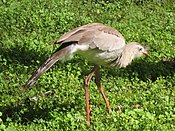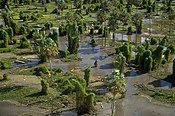List of national parks of Argentina
 From Wikipedia - Reading time: 12 min
From Wikipedia - Reading time: 12 min
The National Parks of Argentina make up a network of 35 national parks in Argentina. The parks cover a very varied set of terrains and biotopes, from Baritú National Park on the northern border with Bolivia to Tierra del Fuego National Park in the far south of the continent. The Administración de Parques Nacionales (National Parks Administration) is the agency that preserves and manages these national parks along with Natural monuments and National Reserves within the country.[1]
The headquarters of the National Parks Service are in downtown Buenos Aires, on Santa Fe Avenue. A library and information centre are open to the public. The administration also covers the national monuments, such as the Jaramillo Petrified Forest, and natural and educational reserves.
History
[edit]The creation of the National Parks dates back to the 1903 donation of 75 km2 (29 sq mi) of land in the Lake District in the Andes foothills by Francisco Moreno, the renowned explorer and academic in Argentina.[2] This formed the nucleus of a larger protected area in Patagonia around San Carlos de Bariloche. At the beginning of the 1920s there was an amazing revival of the national park idea at Lake Nahuel Huapí, which led to the official establishment of the Parque Nacional del Sud on 8 April 1922 by decree of President Yrigoyen.[3] In 1934, a law was passed creating the National Parks system, formalising the protected area as the Nahuel Huapi National Park and creating the Iguazú National Park.[2] Thus, Argentina was the third country in the Americas, after United States and Canada to establish a national parks system.[2] The National Park Police Force was born, enforcing the new laws preventing tree-felling and hunting. Under the direction of the founding director of the National Direction of National Parks Exequiel Bustillo, a conception of national parks focused on economic development and colonization of the region was developed. Beyond touristic development the aim of the parks was to establish national sovereignty over peripherical areas and to protect national borders. Five further national parks were declared in 1937 in Patagonia and the service planned new towns and facilities to promote tourism and education. Six more were declared by 1970.
In 1970 a new law established new categories of protection: National Parks, National Monuments, Educational Reserves, and Natural Reserves. Three national parks were designated in the 1970s. In 1980, another new law affirmed the status of national parks – this law is still in place. The 1980s saw the service reaching out to local communities and local government to help in the running and development of the national parks. Ten more national parks were created with local co-operation, sometimes at local instigation. In 2000, Mburucuyá and Copo National Parks were declared, and El Leoncito natural reserve was upgraded to a national park. Currently, there are 41 protected areas in Argentina,[2] which cover an area of 37,000 km2 (14,286 sq mi) or about 1.5% of the total land area in Argentina.[2]
Map
[edit]National Parks
[edit]See also
[edit]References
[edit]- ^ "Objetivos de la Administración" (in Spanish). Administración de Parques Nacionales. Retrieved August 15, 2015.
- ^ a b c d e "Historia Institucional" (in Spanish). Administración de Parques Nacionales. Retrieved August 15, 2015.
- ^ Kaltmeier, Olaf (2021). National Parks from North to South. An Entangled History of Conservation and Colonization in Argentina. Trier, New Orleans: WVT / UNO. p. 44.
- ^ "Nace el Parque Nacional Aconquija" (in Spanish). Parques Nacionales De Argentina. Retrieved 11 July 2018.
- ^ "Parque Nacional Baritú" (in Spanish). Sistema de Información de Biodiversidad. Retrieved 8 June 2017.
- ^ "Law 26,825" (in Spanish). InfoLEG. Retrieved 8 June 2017.
- ^ "Parque Nacional Bosques Petrificados de Jaramillo" (in Spanish). Sistema de Información de Biodiversidad. Retrieved 8 June 2017.
- ^ "Parque Nacional Calilegua" (in Spanish). Sistema de Información de Biodiversidad. Retrieved 8 June 2017.
- ^ "Parque Nacional Campos del Tuyú" (in Spanish). Sistema de Información de Biodiversidad. Retrieved 8 June 2017.
- ^ "Law 14,366. Boletín Oficial Nº 17,777, p. 7"" (in Spanish). Boletín Oficial de la República Argentina. Retrieved 8 June 2017.
- ^ "Parque Nacional Chaco" (in Spanish). Sistema de Información de Biodiversidad. Retrieved 8 June 2017.
- ^ "Parque Nacional Copo" (in Spanish). Sistema de Información de Biodiversidad. Retrieved 8 June 2017.
- ^ "Parque Nacional El Impenetrable" (in Spanish). Sistema de Información de Biodiversidad. Retrieved 8 June 2017.
- ^ "Parque Nacional El Leoncito" (in Spanish). Sistema de Información de Biodiversidad. Retrieved 8 June 2017.
- ^ "Parque Nacional El Palmar" (in Spanish). Sistema de Información de Biodiversidad. Retrieved 8 June 2017.
- ^ "Decree 18,800/1948. Boletín Oficial Nº 16,096, p. 1" (in Spanish). Boletín Oficial de la República Argentina. Retrieved 8 June 2017.
- ^ "Parque Nacional El Rey" (in Spanish). Sistema de Información de Biodiversidad. Retrieved 8 June 2017.
- ^ "Parque Nacional Iberá" (in Spanish). Sistema de Información de Biodiversidad. Retrieved 1 March 2019.
- ^ a b "Law 12,103" (in Spanish). InfoLEG. Retrieved 8 June 2017.
- ^ "Parque Nacional Iguazú" (in Spanish). Sistema de Información de Biodiversidad. Retrieved 8 June 2017.
- ^ "Parque Nacional Islas de Santa Fe" (in Spanish). Sistema de Información de Biodiversidad. Retrieved 8 June 2017.
- ^ "Ambiente y Rio Negro impulsaran un nuevo parque nacional en el area del Complejo Islote Lobos". Grupo La Provincia (in Spanish). 2020-07-29. Retrieved 2024-08-01.
- ^ "Se creó el Parque Nacional número 40: Islote Lobos". Argentina.gob.ar (in Spanish). 2022-06-15. Retrieved 2024-08-01.
- ^ "Boletín Oficial de la República Argentina". www.boletinoficial.gob.ar. Retrieved 2024-08-01.
- ^ a b "Law 19,292" (in Spanish). InfoLEG. Retrieved 8 June 2017.
- ^ "Parque Nacional Lago Puelo" (in Spanish). Sistema de Información de Biodiversidad. Retrieved 8 June 2017.
- ^ a b c d e "Decree 9,504/1945" (in Spanish). InfoLEG. Retrieved 8 June 2017.
- ^ "Parque Nacional Laguna Blanca" (in Spanish). Sistema de Información de Biodiversidad. Retrieved 8 June 2017.
- ^ "Parque Nacional Lanín" (in Spanish). Sistema de Información de Biodiversidad. Retrieved 8 June 2017.
- ^ "Decree 609/1976. Boletín Oficial Nº 23,421, p. 2-3" (in Spanish). Boletín Oficial de la República Argentina. Retrieved 8 June 2017.
- ^ "Parque Nacional Lihué Calel" (in Spanish). Sistema de Información de Biodiversidad. Retrieved 8 June 2017.
- ^ "Parque Nacional Los Alerces" (in Spanish). Sistema de Información de Biodiversidad. Retrieved 8 June 2017.
- ^ "Parque Nacional Los Arrayanes" (in Spanish). Sistema de Información de Biodiversidad. Retrieved 8 June 2017.
- ^ "Parque Nacional Los Cardones" (in Spanish). Sistema de Información de Biodiversidad. Retrieved 8 June 2017.
- ^ "Parque Nacional Los Glaciares" (in Spanish). Sistema de Información de Biodiversidad. Retrieved 8 June 2017.
- ^ "Parque Nacional Mburucuyá" (in Spanish). Sistema de Información de Biodiversidad. Retrieved 8 June 2017.
- ^ "Parque Nacional Monte León" (in Spanish). Sistema de Información de Biodiversidad. Retrieved 8 June 2017.
- ^ "Parque Nacional Nahuel Huapi" (in Spanish). Sistema de Información de Biodiversidad. Retrieved 8 June 2017.
- ^ "Parque Nacional Patagonia" (in Spanish). Sistema de Información de Biodiversidad. Retrieved 8 June 2017.
- ^ "Parque Nacional Perito Moreno" (in Spanish). Sistema de Información de Biodiversidad. Retrieved 8 June 2017.
- ^ "Parque Nacional Predelta" (in Spanish). Sistema de Información de Biodiversidad. Retrieved 8 June 2017.
- ^ "Parque Nacional Quebrada del Condorito" (in Spanish). Sistema de Información de Biodiversidad. Retrieved 8 June 2017.
- ^ "Parque Nacional Río Pilcomayo" (in Spanish). Sistema de Información de Biodiversidad. Retrieved 8 June 2017.
- ^ "Parque Nacional San Guillermo" (in Spanish). Sistema de Información de Biodiversidad. Retrieved 8 June 2017.
- ^ "Parque Nacional Sierra de las Quijadas" (in Spanish). Sistema de Información de Biodiversidad. Retrieved 8 June 2017.
- ^ "Parque Nacional Talampaya" (in Spanish). Sistema de Información de Biodiversidad. Retrieved 8 June 2017.
- ^ "Parque Nacional Tierra del Fuego" (in Spanish). Sistema de Información de Biodiversidad. Retrieved 8 June 2017.
- ^ "Parque Nacional Traslasierra" (in Spanish). Sistema de Información de Biodiversidad. Retrieved 8 June 2017.
- ^ "Un parque nacional en una histórica estancia de Córdoba". La Voz del Interior.
External links
[edit]- National Parks Administration (Spanish/English)
 KSF
KSF
































